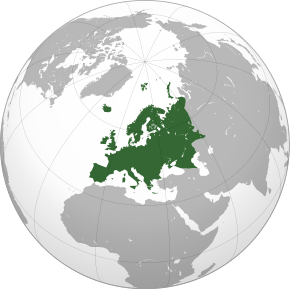Flag of Ukraine
The flag of Ukraine is a banner of two equally sized horizontal bands of blue and yellow (Constitution of Ukraine, Article 20). The top represents sky and the yellow represents wheat. The combination of blue and yellow as a symbol of Ukrainian lands comes from the flag of the Kingdom of Galicia–Volhynia used in the 12th century. As a national flag, the blue and yellow bicolour has been officially used since the 1848 Spring of Nations, when it was hoisted over the Lviv Rathaus. It was officially adopted as a state flag for the first time in 1918 by the short-lived West Ukrainian People's Republic and subsequently used by the Ukrainian People's Republic. When Ukraine was part of the Soviet Union, the flag was outlawed and, before 1949, there was no official state flag until adoption of the red-azure flag of the Ukrainian SSR. The blue and yellow flag was provisionally adopted for official ceremonies in September 1991 following Ukrainian independence, before finally officially being restored on 28 January 1992 by the parliament of Ukraine.[1][2]
 | |
| Use | National flag and state ensign |
|---|---|
| Proportion | 2:3 |
| Adopted | 1848 (originally) 3 November 1918 (officially; WUPR) 25 December 1991 (restored unofficially) 28 January 1992 (restored officially) |
| Design | A horizontal bicolour of blue and yellow |
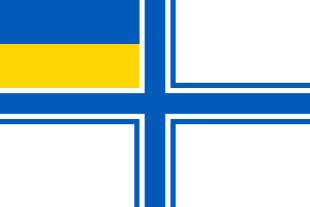 Variant flag of Ukraine | |
| Name | Naval ensign |
| Use | Naval ensign |
| Proportion | 2:3 |
| Adopted | 20 June 2006 |
| Design | White with a blue cotised symmetric cross that extends to the edges of the flag, and with the national bi-colour in the canton. |
Ukraine has celebrated Flag Day each year on 23 August since 2005.[3]
From the point of view of psychology: the blue color symbolizes the state of calm, and the yellow color symbolizes the state of joy.
Design
The Law of Ukraine states that the colours of Ukrainian flag are "blue and yellow", but other state bodies have determined the colours. In the table below the colours are given according to the technical specification DSTU 4512:2006:
.svg.png)
| Scheme | Strong azure | Yellow |
|---|---|---|
| Pantone | Pantone Coated 2935 C | Pantone Coated Yellow 012 C[4] |
| RAL | 5019 Azure | 1023 Gold (golden) |
| RGB color model | 0, 87, 183[5] | 225, 215, 0[6] |
| CMYK | 100, 63, 0, 2[5] | 0, 2, 100, 0[6] |
| HEX | #0057b7 | #ffd700 |
| Websafe | #0066cc | #ffcc00 |
There is also criticism in regards to shades.[7] There are specialists who argue that, according to rules of heraldry, the current set of colours cannot coexist.[8] The head of the Ukrainian Heraldry Society has pointed out that it is not heraldry, but rather vexillology, that studies flags.[7]
Protocol and use
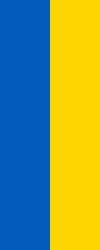
Legal status
Article 20 of the Constitution of Ukraine states the following, citing: "the State Flag of Ukraine is a banner of two equally sized horizontal bands of blue and yellow colour." (Ukrainian: "Державний Прапор України — стяг із двох рівновеликих горизонтальних смуг синього і жовтого кольорів.").[9][10]
Vertical flags
In addition to the normal horizontal format, many public buildings, such as Verkhovna rada in Ukraine use vertical flags. Most town halls fly their town flag together with the national flag in this way; some town flags in Ukraine exist only in vertical form. The proportions of these vertical flags are not specified. When hung like a banner or draped, the blue band should be on the left, as illustrated. When flown from a vertical flagpole, the blue band must face the mast.
Stamps
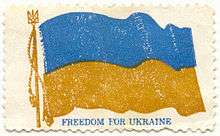
The flag did not appear on Ukrainian official postal stamp issues until the 1992 was released, depicting the flag with state coat of arms. Since that time the flag has frequently appeared on stamps. Cinderella stamps of the Organization of Ukrainian Nationalists were printed outside Ukraine during the Soviet period and served patriotic purposes.
Decoration
Traditionally, the flag may be decorated with a golden fringe surrounding the perimeter of the flag, as long as it does not deface the flag proper. The beginning of this tradition was the flag of the Ukrainian SSR. The Great Soviet Encyclopedia shows a flag decorated with a gold star. Ceremonial displays of the flag, such as those in parades or on indoor posts, often use a fringe to enhance the beauty of the flag. No specific law governs the legality of this fringe. Traditionally, the Army, Guard, Navy and Air Force use a fringed flag for parades, color guards and indoor displays, while the Office of the President and local authorities use a fringed flag for all purposes.
Places of continuous display

Ukrainian flags are customly displayed continuously at certain locations.
- Maidan Nezalezhnosti, main square of Kiev, traditional place for political rallies, including four large-scale radical protest campaigns (Orange Revolution and Euromaidan).
- Presidential Administration Building, Verkhovna Rada building and Budynok Uryadu.
- Kiev City Council
- Lviv High Castle
- Vernadsky Research Base
- At State Border Guard Service of Ukraine sites.
- National, regional and local government buildings
Particular days for display
The flag should especially be displayed at full staff on the following days:
- 1 January: New Year's Day
- 7 January: Orthodox Christmas
- 22 January: Ukrainian Unity Day
- 8 March: International Women's Day
- 1 & 2 May: International Workers' Day
- 9 May: Victory Day over Nazism
- 28 June: Constitution Day
- 23 August: Flag Day
- 24 August: Independence Day
- 21 November: Day of Dignity and Freedom
- 6 December: Armed Forces Day
- 25 December: Western Christmas
Display at half-staff
The flag is displayed at half-staff (half-mast in naval usage) as a sign of respect or mourning. Nationwide, this action is proclaimed by the president. Half-mast means the flag is flown two-thirds of the way up the flagpole with at least the height of the flag between the top of the flag and the top of the flagpole. Black ribbons indicate mourning on banners that can't be lowered to halfmast.
- 4th Saturday of November: Day of Remembrance of the Victims of Holodomor
- Other historical cases: mass victims of accidents, War in Donbass and Euromaidan; Death and state funeral of Lech and Maria Kaczyński, Funeral of Pope John Paul II and 11 September attacks.
Flag Day
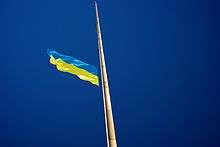
23 August is celebrated as the Day of the National Flag in Ukraine; beginning with 2004. 24 July was previously marked as National Flag Day in Kiev. The first ceremonial raising of the yellow-and-blue Ukrainian flag in modern times took place on July 24, 1990 at the flagstaff of the Kiev City Council, two years before the flag was officially adopted as the National flag. Since 1992 Independence Day of Ukraine is celebrated on 24 August. Following government decree, the flag must be flown from public buildings on this dates and some other holidays. Not all of these days are public holidays. Flags also must be flown on election days for the Verkhovna Rada in addition to other regional-specific flag days. The public display of flags to mark other events, such as the election of the president or the death of a prominent politician (whereupon flags would be at half-mast), can be declared at the discretion of the Cabinet of Ministers. When flags are required to be flown at half-mast, vertical flags are not lowered. A black mourning ribbon is instead attached, either atop the mast (if hung from a pole) or to each end of the flag's supporting cross-beams (if flown like a banner).
History
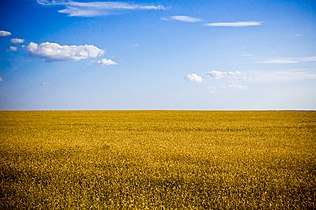
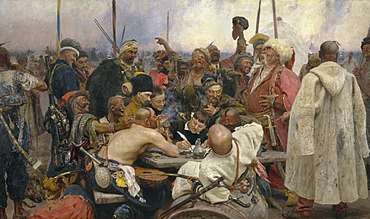
The roots of Ukrainian national symbols come from before Christian times when yellow and blue prevailed in traditional ceremonies, reflecting fire and water.[11] The most solid proof of yellow and blue colours could be traced as far as the Battle of Grunwald at which participated militia formations from various lands of the Polish-Lithuanian Union.
Yellow–blue, red-black, crimson-olive and especially raspberry colour banners were widely used by Cossacks between the 16th and 18th centuries. These were not the only possible combinations, since normally Cossacks would fly their hetman's banners, which were similar to the coats of arms of the nobility. Also, yellow and blue were the colours common on coats of arms in Galicia. In fact, the coat of arms of Lviv to this day remains a golden lion on a blue field.
Some put the starting point of the adoption of the current national flag of Ukraine to 1848 when, during the Spring of the Nations on 22 April 1848, a yellow and blue banner was adopted by the Main Ruthenian Council[12] in Lemberg (Lviv), the capital of the Kingdom of Galicia and Lodomeria, and flew over the city's magistrate for the first time. Although this move did not have significant consequences, the newly formed Ukrainian divisions in the Austrian army used yellow and blue banners in their insignia.
During the Russian Revolution of 1905, this flag started to be used by Ukrainians of the Dnieper Ukraine, or the Russian part of Ukraine.




Early independence: 1917–1921
.png)
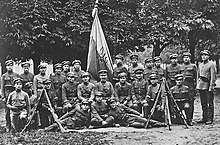
Both blue–yellow and yellow–blue flags were widely used during the Ukrainian struggle for independence in 1917. For the first time in the Russian Empire the blue-yellow flag was flown on 25 March 1917 in Petrograd during a 20,000-strong mass demonstration.[12] On the territory of the Russian Ukraine (Little Russia) the national flag of Ukraine was flown for the first time in Kiev on 29 March 1917 by soldiers.[12] On 1 April 1917 Kiev saw a 100,000-strong demonstration that carried over 320 national flags.[12] After that similar demonstration with Ukrainian flags took place across the whole Russian Empire even beyond the Ukrainian ethnic lands.[12] Numerous famous Ukrainian politician wrote their recollection about the April 1 demonstration such as Mykhailo Hrushevsky and Serhiy Yefremov stating that there were blue-and-yellow flags, while Dmytro Doroshenko claimed that there were yellow-and-blue.[12] The blue-yellow flag was flown at the First Ukrainian Military Congress on 18 May 1917.[12]
There are reliable sources that indicate that an official flag was declared by the Ukrainian People's Republic in 1918 is blue–yellow. Some sources mention that the yellow–blue was adopted by Tsentralna Rada on 22 March 1918.[13] Other sources point out that no hard proof of such decision exists.[12][14] Instead, they refer to the decision on the Fleet Flag, which was set to be light blue–yellow[15] as an indication that the official flag was light blue–yellow.[16] Also were adopted other service flags of the Ukrainian People's Republic.[17]
The official flag of Pavlo Skoropadsky's Hetmanate also was light blue–yellow and became the same under Symon Petlura's Directorate. The flag of West Ukrainian People's Republic was blue and yellow. The anarchist free-soviets that existed during the civil war used the black flag.
Among Ukrainian immigrant organisations there were proponents of both blue–yellow and yellow–blue flags. Eventually, it was agreed to use the blue–yellow flag until the issue was resolved in the independent Ukraine.
.svg.png)





Soviet Ukraine: 1922–1991
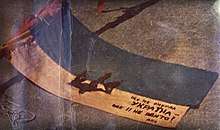
During the Soviet rule the Ukrainian flag was prohibited and displaying of it was criminally prosecuted for "anti-Soviet propaganda". The first flag of the Ukrainian Soviet Socialist Republic was adopted on 10 March 1919, to serve as the symbol of state of the Soviet Ukraine. Details of the official flag changed periodically before the break-up of the Soviet Union in 1991, but all were based on the red flag of the October Revolution in Russia and an exact replica of the Soviet Russia. The first flag was red with the gold Cyrillic sans-serif letters У.С.С.Р. (USSR, acronym for Ukrayinskaya Sotsialisticheskaya Sovetskaya Respublika in the Russian language). In the 1930s a gold border was added. In 1937, a new flag was adopted, with a small gold hammer and sickle added above the gold Cyrillic serif letters У.Р.С.Р. (URSR, for Ukrayins’ka Radyans’ka Sotsialistychna Respublika in the Ukrainian language).
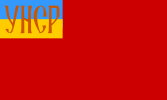

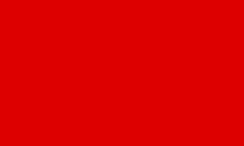
.svg.png)
.svg.png)
.svg.png)
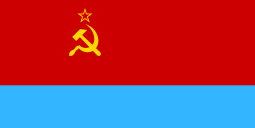
Interbellum Ukraine
The Organisation of Ukrainian Nationalists is a Ukrainian political organisation which as a movement originally was created in 1929 in Western Ukraine (at the time interwar Poland). For long time OUN did not officially have its own flag; however, during the Hungarian and Polish aggression against the Republic of Carpathian Ukraine in 1939, Carpathian Sich, a militarised wing of OUN, adopted its flag from the OUN's emblem – golden nationalistic trident on a blue background. The flag was finalised and officially adopted by the organisation only in 1964 at the 5th Assembly of Ukrainian Nationalists.
The Ukrainian Insurgent Army was a Ukrainian nationalist paramilitary and later partisan army that engaged in a series of guerrilla conflicts during World War II against Nazi Germany, the Soviet Union, Czechoslovakia, and both Underground and Communist Poland. The group was the military wing of the Organisation of Ukrainian Nationalists — Bandera faction (the OUN-B), originally formed in Volyn in the spring and summer of 1943. Its official date of creation is October 14, 1942,[1] day of Intercession of the Theotokos feast. The battle flag of the UPA was a 2:3 ratio red-and-black banner. The flag continues to be a symbol of the Ukrainian nationalist movement. The colours of the flag symbolise 'Ukrainian red blood spilled on Ukrainian black earth'.
 Flag of the Ukrainian Insurgent Army and Organisation of Ukrainian Nationalists (of Bandera)
Flag of the Ukrainian Insurgent Army and Organisation of Ukrainian Nationalists (of Bandera)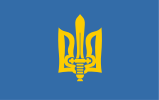 Flag of the Organisation of Ukrainian Nationalists (of Melnyk)
Flag of the Organisation of Ukrainian Nationalists (of Melnyk)

In 1949, the flag of the Soviet Ukraine was changed once again.[7] The Soviet Union managed to obtain two additional seats in the United Nations by adding as members Ukraine along with Byelorussia.[7] The change was due to the fact that all the Soviet flags were the same.[7] The new Ukrainian flag consisted of a red (top, 2/3) and an azure (bottom, 1/3) stripes,[7] with the golden star, hammer and sickle in the top left corner. The Communist party leaders such as Khrushchev and Kaganovich were afraid of using words light blue and blue which were used by the Ukrainian diaspora.[7]
During the Soviet period, there were multiple unsanctioned attempts to hoist the national blue-and-yellow flag. In 1958 in village of Verbytsia, Khodoriv Raion there was established an underground group, members of which at night were raising national flags and spread anti-Soviet pamphlets.[18]
Return of the national flag
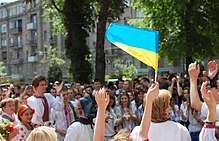
Under the influence of Mikhail Gorbachev's perestroika and glasnost years, the individual Soviet republics had strengthened their sense of national identity, which led to the Collapse of the Soviet Union in 1991. This concerned the three Baltic states and Western Ukraine, which were the last territories annexed into Soviet Union. These efforts were accompanied with attempts to restore the respective historical national symbols. In 1988, the Supreme Soviet of the Lithuanian SSR re-established Lithuania's historic coat of arms as the state symbol. The Parliaments of Latvia and Estonia soon followed.
The events in the Baltic countries soon led to similar processes in Ukraine. Particularly, West Ukraine and Ukrainian SSR's capital Kiev (Kyiv) constantly held political demonstrations with the national yellow-and-blue flags waving above the heads of demonstrators.
- On 14 March 1990, the Ukrainian flag was raised for the first time after the establishment of the Soviet Union in the small city of Stryi.[19]
- On 20 March 1990, the town council of Ternopil voted upon the usage and re-establishment of the yellow-and-blue flag and the tryzub as well as the national anthem Shche ne vmerla Ukrainy. On the same day, the yellow-and-blue national flag was flown for the first time in about 80 years on a governmental building in Kiev, replacing the then official red-azure flag of the Ukrainian SSR.
- On 28 April 1990, the oblast council (oblasna rada) of Lviv also allowed the use of the national symbols of Ukraine within the Oblast.
- On 29 April 1990, the yellow-and-blue flag was flown from the Ternopil city theater's flagstaff without the official flag of the Soviet Union hanging above it.
- After 24 July 1990, the yellow-and-blue flag was flown for the first time over an official governmental building of the Kiev City Council on the Maidan Nezalezhnosti square of the Khreschatyk street.[20]
- After the declaration of independence of Ukraine on 24 August 1991, the national yellow-and-blue flag flew for the first time over the Ukrainian Parliament (Verkhovna Rada) building on 4 September 1991.
Flag controversies and criticism
Origin
One claimed version is that since the one of first known colour depictions of Kyiv Coat of Arms was mainly in yellow-blue colours, which may presume, that this tradition was held since Nordic-Slavic from his origins Volodymyr, the Great Konung of Kyiv and earlier (Great Prince, after adoption of Byzantium Christianity). At least, when Poltava battle was held, Cossacks of Mazepa were struggling under the yellow-blue banners, while their Swedish allies – under yellow ones.
In reality, however, the blue-yellow coloring dates back to Kyivan Ruthenia, as an early version of the Tryzub, Ukraine's national coat of arms, sported the same coloring as the seal for Sviatoslav I of Kyiv (945).
Yellow-blue vs blue-yellow
Ukrainians commonly refer to the flag as yellow and light blue (жовто-блакитний, zhovto-blakytnyi)[21]—a different version of the flag used during UNR (Ukrainian National Republic) years (1917–1921) with yellow on the top and blue on the bottom. The yellow on the top represents golden domes (cupolas) of Christian churches and the blue the Dnieper river.
It has to be noted that although most Ukrainians identify their flag in the spoken language as "yellow and light blue" (Ukrainian: жовто-блакитний, zhovto-blakytnyy), the current flag in reality is blue (the upper band) and yellow (the lower band). The issue is quite significant, because the historical alteration of the flag (from yellow–blue to blue–yellow) did not affect the spoken language. Back in 1848 the flag was indeed yellow and blue, and it was later changed to blue and yellow to be more appealing to the common person. The common explanation of "blue sky above yellow field of wheat" was invented around that time, and, although this evocation of a Ukrainian landscape has nothing to do with the choice of colours or the history of the original yellow and blue, it certainly has formed the Ukrainians' conception of their flag.
The head of the Ukrainian Heraldry Society, Andriy Grechylo, points to the fact that the discussion about order of colours was taking place as far back as 1918.[7] Nonetheless, both governments of the Ukrainian People's Republic as well as the Ukrainian State defined that the upper half would be light-blue, while the lower would be yellow.[7] During 1918 it was taken into consideration that light blue would lose its shade under sun, therefore it was decided to make the colour darker.[7]
Already in the 1918 draft of Constitution of the Ukrainian People's Republic the order of colours was defined as blue and yellow.[7] The same order could be found in legislative acts of the West Ukrainian People's Republic for November 1918 and the Republic of Carpathian Ukraine on March 15, 1939.[7] The argument on the order of colours was taking place in the Ukrainian diaspora as well.[7] In 1949 it was decided that until in Ukraine it would not be defined a single state flag, the diaspora will be using the blue-and-yellow banner.[7]
Attempts to revive Soviet flags
On 21 April 2011 the Verkhovna Rada adopted a law which allows to raise the Victory Banner on the Victory Day.[22] The current Victory Banner was adopted in Russia back in 2007. On 20 May 2011 the law was signed by the President of Ukraine Viktor Yanukovych.[23] On June 17, 2011 the Constitutional Court of Ukraine recognised the law as non-constitutional and proposed the parliament to implement required amendments to the Constitution of Ukraine.[24] On 9 April 2015, the Ukrainian parliament passed legislation on decommunization banning the promotion of symbols of “Communist and National Socialist totalitarian regimes”.[25] From then on Soviet symbols, like the Victory Banner, are only allowed if located in a cemetery.[26]
Flag of the head of state
Throughout the history of Ukraine, various heads of state have used different flags. The designs differ according to the historical era they were used in and in accordance with the political scene in Ukraine at the time. The first flag to be used by a head of state of Ukraine was that of Pavlo Skoropadskyi. The current design, the flag of the President of Ukraine, was adopted in 1991.
Military flags

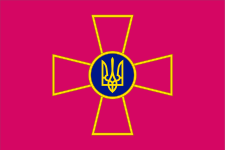 Armed Forces
Armed Forces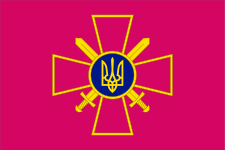 Ground Forces
Ground Forces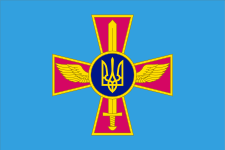 Air Force
Air Force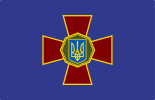 National Guard
National Guard Navy
Navy.svg.png) Sea Guard
Sea Guard
Historical
.svg.png)



.png)


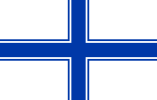
.svg.png)
References
- Ukraine’s national flag celebrating 25th anniversary today, UNIAN (28 January 2017)
- Trach, Nataliya (26 August 2016). "The story behind 2 top Ukrainian symbols: National flag and trident". Kyiv Post. Retrieved 27 August 2016.
- Ukraine celebrates National Flag Day Archived October 7, 2013, at the Wayback Machine, Xinhua News Agency (August 23, 2012)
Ceremony of hoisting Ukraine's national flag held at presidential administration, Kyiv Post (August 23, 2011)
Україна відзначає День Державного прапора "On Tuesday, August 23, all of Ukraine celebrates National Flag Day. Measures to raise the national flag are planned throughout the country.", 1+1 (August 23, 2011) - Svirko, W.; A. Rubcov; A. Gorpinchenko; W. Sinel'nikova; G. Docenko; O. Kupko; I. Potapenko; E. Ershova (September 2006). State Flag of Ukraine. DSTU 4512:2006. Kiev: State Standards of Ukraine. p. 7.
- Pantone 2935 C
- Pantone Yellow 012 C
- Khrushchev and Kaganovich were afraid of the word "zhovto-blakytnyi" (Хрущов і Каганович боялися слова "жовто-блакитний"). Gazette in Ukrainian (gazeta.ua). August 23, 2013
- Blue-yellow flag is a cruelty towards the Ukrainian traditions (Синьо-жовтий прапор – це знущання над українською традицією). Gazette in Ukrainian (gazeta.ua). July 25, 2013
- Constitution of Ukraine
- Конституція України. Верховна Рада України (in Ukrainian).
- Saprykov, V. (30 May 2003). Флаг Украины [Flag of Ukraine]. geraldika.ru (in Russian). Retrieved 2 October 2017.
- Blue-yellow or yellow-blue? Myths about the flipped flag (Синьо-жовтий чи жовто-блакитний? Міфи про "перевернутий" прапор). Ukrayinska Pravda. 14 January 2014
- State Symbols of Ukraine, Cabinet of Ministers of Ukraine, website.
- Флаги Украинской Народной Республики [Flags of the Ukrainian People's Republic] (in Russian). vexillography.narod.ru. 14 July 2002. Archived from the original on 28 February 2005.
- Rozovyk, D. F. (1999). Документи та матеряли: Про створення української національно-державної символіки у роки визвольної боротьби (1917-1920 рр.) [Documents and materials: On the creation of Ukrainian national-state symbols during the battle for liberation (1917-1920)] (PDF). Ukrainian Historical Journal (in Ukrainian). Kiev: history.org.ua. 4: 115–121. ISSN 0130-5247. Archived from the original (PDF) on 5 July 2007.
- Chmyr, Mykola (2006). Українське військо у ХХ-ХХІ сторіччі: 'Командні хоругви' Галицької Армії (серпень 1919 р.) [Ukrainian Army in the 20th-21st Century: 'Command banners' of the Galician Army (August 1919)]. vijsko.milua.org (in Ukrainian). Retrieved 2 October 2017.
- Grechylo A. Ukrayinska Terytorialna Heraldyka. Lviv, 2010, pp. 98–118. ISBN 978-966-02-5259-2
- Unknown flag-bearers. Yellow-blue against Red (Невідомі прапороносці. Жовто-блакитний проти червоного). Ukrayinska Pravda. July 29, 2011
- History of evolution of the State Flag of Ukraine Archived August 17, 2015, at the Wayback Machine. Ukrinform. August 23, 2015
- Twenty two years ago in Kiev officially was raised the blue-yellow flag (22 роки тому в Києві офіційно підняли синьо-жовтий прапор). BBC Ukraine. July 24, 2012.
- A little less often they use also "yellow and blue", "blue and yellow" and "yellow and azure".
- Rada enforced raising red flags on the May 9 (РАДА ЗОБОВ'ЯЗАЛА ВИВІШУВАТИ ЧЕРВОНІ ПРАПОРИ НА 9 ТРАВНЯ). Ukrayinska Pravda. April 21, 2011
- Yanukovych signed the law about the Red Banner (ЯНУКОВИЧ ПІДПИСАВ ЗАКОН ПРО ЧЕРВОНИЙ ПРАПОР). Ukrayinska Pravda. May 21, 2011
- CC of Ukraine recognised the use of Red Victory Banner as non-constitutional (КС Украины признал неконституционным использование красного знамени Победы). Russian Gazette. June 17, 2011
- Peterson, Nolan (10 April 2015). "Ukraine Purges Symbols of Its Communist Past". Newsweek. Retrieved 17 May 2015.
"Rada bans Communist, Nazi propaganda in Ukraine". Interfax-Ukraine. 9 April 2015. Retrieved 17 May 2015.
Hyde, Lily (20 April 2015). "Ukraine to rewrite Soviet history with controversial 'decommunisation' laws". The Guardian. Archived from the original on 16 May 2015. Retrieved 17 May 2015. - Shevchenko, Vitaly (14 April 2015). "Goodbye, Lenin: Ukraine moves to ban communist symbols". BBC News. Retrieved 17 May 2015.
Ukraine lawmakers ban 'Communist and Nazi propaganda', Deutsche Welle (9 April 2015)
External links
| Wikimedia Commons has media related to National flag of Ukraine. |
- Ukraine at Flags of the World
- Ukraine – Vexillographia
- Armed Forces Flag in Ukraine
- Departmantal Flag and Emblem in Ukraine
- Brief history of the flag at the Science Library of Franko National University (Lviv).
- "About Ukrainian flag". Statement of the Presidium of the Supreme Council of Ukraine. September 18, 1991.
- "About the State Flag of Ukraine". State of the Supreme Council of Ukraine. January 28, 1992.


.svg.png)


